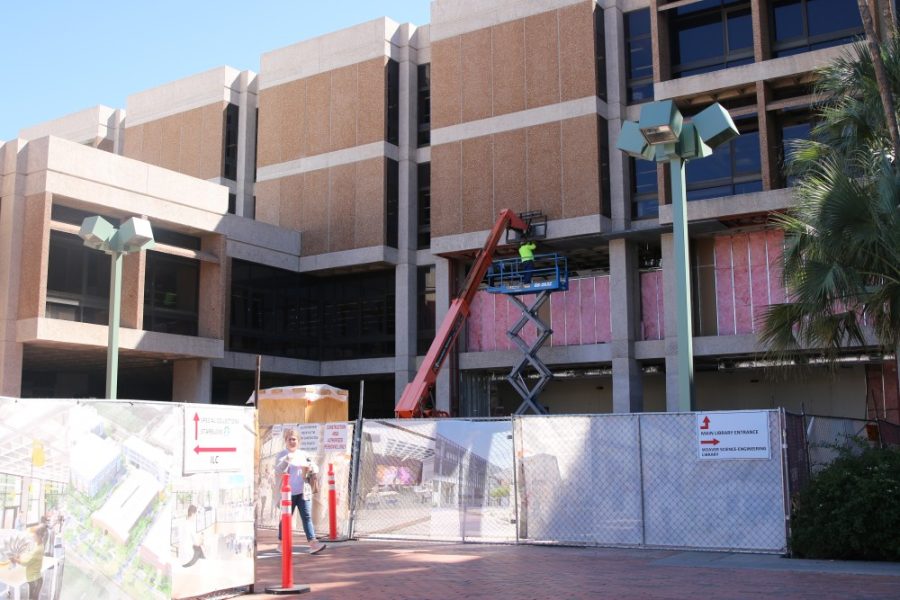Want a quiet place to study the night before a big test or grind on a paper due the next day? Looking for books, articles, or other sources for an assignment? University of Arizona libraries are the place for you!
There are four libraries on campus: the Main Library, the Science-Engineering Library, the Fine Arts Library and the Arizona Health Sciences Library.
Study rooms
There are several walk-in and reservable spaces available for students to utilize. Walk-in spaces include silent study rooms, computer study areas, multimedia zones, reflection rooms, family study rooms, scholars’ corner and quiet study areas. Reservable spaces include quiet study rooms (for 1-2 people), group study rooms (3-8 people) and collaboration rooms (9-16 people).
The variety of spaces is attributed to the wide array of preferences that students might have, explained Kenya Johnson, director of marketing communications and events for UA Libraries.
“Everyone has different ‘likes’ when it comes to study spaces,” Johnson wrote in an email. “It really depends on the person. If you prefer a quiet study room where you can concentrate, you can schedule a room online. If you like to work in open spaces, we have even more options now thanks to the renovations at the Main Library and Weaver Science-Engineering Library.”
Due to social distancing, the Science-Engineering Library will only permit one person per study room*.
The Main Library and the Science-Engineering Library recently underwent renovations; some changes include more natural light, more indoor and outdoor study spaces and more comfortable places to study.
The Main Library and Fine Arts Library are currently closed, but the Science-Engineering Library is open according to Johnson*.
Technology
Students can borrow a wide variety of technology from the libraries, including (but certainly not limited to) laptops, tablets, DSLR cameras, calculators and computer accessories like charger cables and adapters.
Technology is limited due to COVID-19, but enrolled students in need of a library laptop can email the library at library@arizona.edu to schedule an appointment.
There are also several public computers available inside UA libraries are specifically for public use. Individuals wishing to use a public computer will need to obtain a computer card from the second floor of the science library. Once this is done, any available computer may be used for a 60-minute session.
Johnson also said students wishing to use a library can use the ones available in the computer study area in the science library, logging on using a NetID*.
Seed Library
Fun fact: The Science-Engineering Library contains a seed library!
According to its site, “The Seed Library is home to a collection of seeds that you can take home and grow in your garden. This is a free service available to UA students, faculty, staff, and the Tucson community thanks to a collaboration between the University of Arizona Libraries and the Students for Sustainability Garden Committee.”
Students would normally need to fill out a form and they can bring home any seeds of their choice to plant in their garden, but the garden will be closed for the fall 2020 semester*.
Resources and People
Finally, it wouldn’t be a library without mentioning its collection of books! UA Libraries contain over nine million print volumes, electronic books and journals in its collection. If that isn’t enough for you, students and other members of the university community can use WorldCat Discovery to request books from libraries worldwide. There are also just under a thousand research databases listed on the University Libraries’ website.
To manage such a wide variety of media, UA libraries employs over 350 librarians, staff and student workers. These people can provide both invaluable information and insight into your studies or personal interests.
“Librarians are the most important resource in the library as they can provide you with guidance on the best resources we have to offer, offer support on your research, and connect you to the services you’re seeking,” said Anthony Sanchez, assistant librarian at University Libraries.
Though University Libraries might not be as crowded this fall semester due to COVID-19 mitigation measures, Johnson still encourages students to use the libraries’ resources, whether online or otherwise.
“We miss seeing students in our libraries,” Johnson said, “and look forward to welcoming you back.”
*Editor’s Note: This article has been updated with recent information from Kenya Johnson regarding the library accessibility for the upcoming semester.
Follow Kristijan Barnjak on Twitter








